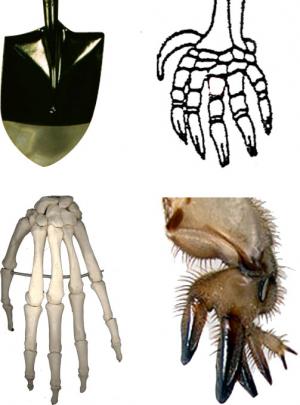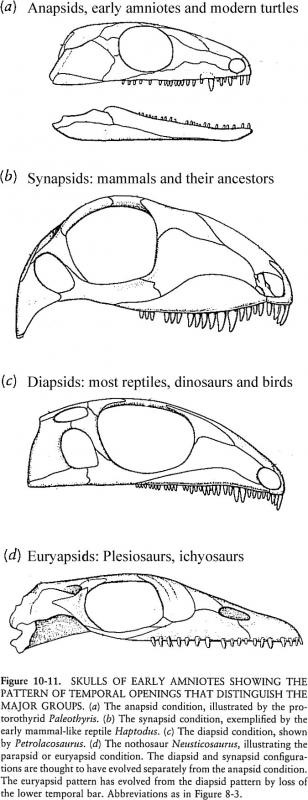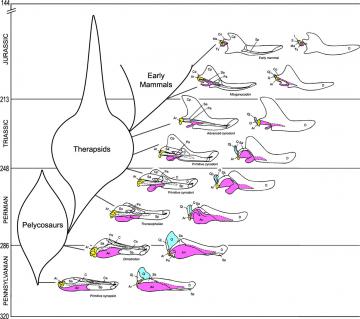Explore Evolution claims that because transitional fossils come in different sizes, they aren't really transitional
Summary of problems with claim: The point of presenting fossils at the same size is to illustrate the appearance of novel anatomical structures. Size is a feature that changes with age, diet and changes relatively easily in response to evolutionary pressures. The shift from three bones on each side of the lower jaw to a single dentary bone is far rarer and more informative about evolutionary history.
Full discussion: Explore Evolution takes umbrage at a diagram from T.S. Kemp's 2005 book The Origin and Evolution of Mammals. Page 21 of Explore Evolution shows a series of skulls (Figure 1:6), each the same size, and then compares this on page 29 (Figure 1:8) to the same skulls at relative sizes, where some are much larger than others.
 Scaling for Clarity: A shovel, a mole paw, a human hand, and a mole cricket forelimb. Altering the scale is done for clarity, not deception, as the authors well know. Explore Evolution does the very same scaling in its Figures 2:1 and 2:4, on pages 41 and 43, where the arm of a bat, a porpoise, a horse, and a human (2:1) and cricket and a mole (2:4) are all drawn at similar scales.
Scaling for Clarity: A shovel, a mole paw, a human hand, and a mole cricket forelimb. Altering the scale is done for clarity, not deception, as the authors well know. Explore Evolution does the very same scaling in its Figures 2:1 and 2:4, on pages 41 and 43, where the arm of a bat, a porpoise, a horse, and a human (2:1) and cricket and a mole (2:4) are all drawn at similar scales.
In Figure 1:8 the miniscule size of Thrinaxodon or Probainognathus makes it impossible to identify bones and structures. In Figure 1:6, critical features which distinguish mammals from their amniote ancestors (structures like the opening in the bones behind the eyes and the locations of bones in the lower jaw) can be seen quite clearly. Mammals range in size from a few grams (e.g., the Bumblebee Bat) to several tons (e.g., a Blue Whale), but nevertheless, all of them have a single bone (the dentary) that makes up their lower jaw, hair, mammary glands, and numerous other features that diagnoses them as "mammals." Indeed, the range of sizes seen in domestic dogs is greater than the range shown in figure 1:8 (see the discussion of dog size and morphology in the critique of chapter 7), and that size range does not interfere with our understanding of the "close genealogical relationship" (Explore Evolution, p. 29) between dogs. The illustration in figure 1:6 (from Kemp's The Origin and Evolution of Mammals) is meant to illustrate the transition of a particular set of structures, and not (as Explore Evolution suggests) to make a point about the size of the organisms. Explore Evolution s point about size is ultimately a semantic and silly argument which misrepresents (or misunderstands) what scientists look for in assessing fossil transitions. Size is not regarded as a factor which signifies "close genealogical relationship," while the arrangement of post-orbital and jaw bones is significant.
Proper scaling in figures is a great pedagogical tool that helps students and researchers in their comparative anatomy - and at least in professional publications, scale bars are commonly included so viewers and critics can ascertain specimen size. Explore Evolution s figure 1.8 hides information, obscuring evidence of the evolution of evolutionarily significant features like postdentary bones whose modification is coupled to the origin of the mammalian middle ear.
In evaluating the evolution of modern mammals from the amniote ancestors of reptiles and mammals, there are several important traits that scientists examine. Mammalogy, by Vaughan, et al. (2000) lists 25 major features, selected from a much longer list of traits distinguishing mammals. The traits that do not fossilize from that list include skin glands (mammary glands, sweat glands, sebaceous glands), hair, specialized muscles in the skin, the epiglottis, details of the soft anatomy of the lung and diaphragm, brain structures, facial muscles, red blood cells lacking nuclei, and the anatomy of the heart. We will discuss some of them in more detail in the critique of chapter 12.
Skeletal characteristics are easier to identify in fossils. These include a change in the bones of the jaw with a shift of three bones out of the structure of the jaw and their reuse in the ear, a trait paleontologists regard as the dividing line between mammals and their non-mammalian ancestors. Vaughan, et al. explain "By this definition, Mammalia does not include the extinct near-mammals, the Mammaliaformes" (p. 11). Paleontologists debate which fossils represent the earliest mammals because of differing criteria, and the increasingly fine differences between the fossils make it harder to draw a clear line. Vaughan, et al. explain:
when mammals first appeared in the Triassic period, they represented no radical structural departure from the therapsid plan but had attained a level of development that is interpreted by most vertebrate paleontologists as a key indication that the animals had crossed the non-mammalian-mammalian boundary. Many of the mammalian characters discussed in this chapter resulted from evolutionary trends clearly characteristic of therapsids.Terry A. Vaughan, James M. Ryan and Nicholas J. Czaplewski (2000) Mammalogy 4th ed., Saunders College Publishing: Orlando, FL. p. 10 of 565.
The "mammal-like reptiles" that Explore Evolution refers to are these therapsids, as well as other members of the Clade Synapsida. As mentioned above, scientists do not refer to the group as "mammal-like reptiles." The University of California Museum of Paleontology explains "This term is now discouraged because although many had characteristics in common with mammals, none of them were actually reptiles." Reptiles are a lineage which shares a common ancestor with mammals and other synapsids, not a group ancestral to mammals. Understanding that relationship can help clarify much of the confusion that laces the treatment of transitions in Explore Evolution.
The ancestors of modern reptiles, mammals and birds are known as amniotes. That name refers to a feature of the eggs of all those groups, one of several shared, derived characteristics which suggests that those groups share a common ancestor. A common challenge in talking about the transitional forms between mammals and reptiles is attempting to imagine a form intermediate to modern reptiles and modern mammals. In evolutionary terms, a transitional form is a common ancestor of two groups, one which shares traits with earlier forms and possesses a few of the traits which uniquely identify later lineages. We have such fossils illustrating the transition of early amniotes to the several lineages which led to modern mammals and to reptiles.
 Early Amniotes: Despite their morphological similarities, critical differences show that these fossils represent the first branches between the lineages that would go on to produce diverse modern groups. From fig. 10.11 of Robert L. Carroll (1988) Vertebrate Paleontology and Evolution W. H. Freeman and Co.: New York. 698 p. The first skull in the figure at the right shows the basic anatomy of the ancestral condition of the amniote lineage. Of particular importance, there is no hole in the skull behind the eye socket. The lower jaw in all of these fossil species consists of three bones, one of which is on the inside of the jaw, not visible in the illustration.
Early Amniotes: Despite their morphological similarities, critical differences show that these fossils represent the first branches between the lineages that would go on to produce diverse modern groups. From fig. 10.11 of Robert L. Carroll (1988) Vertebrate Paleontology and Evolution W. H. Freeman and Co.: New York. 698 p. The first skull in the figure at the right shows the basic anatomy of the ancestral condition of the amniote lineage. Of particular importance, there is no hole in the skull behind the eye socket. The lower jaw in all of these fossil species consists of three bones, one of which is on the inside of the jaw, not visible in the illustration. That first skull dates to roughly 315 million years ago, and represents one of the earliest known amniotes. Fossils of this and other early amniotes are found in the fossilized stumps of a species of tree which grew in floodplains. These early amniotes took refuge in the hollow stumps of those trees, and without the discovery of those stumps, our knowledge of the base of the amniote tree of life would be much poorer. Those sorts of historical contingencies are common in paleontology, and help explain the unevenness of the fossil record.
The next skull dates from around 300 million years ago, and belongs to an ancestor of mammals. The main difference between it and the first species is that there is a gap between two bones behind the eye socket. This gap may have allowed greater freedom for jaw muscles, or may have carried neither adaptive benefit nor harm. The size of that gap varies between fossils, as does the size of that gap, but its existence marks descendants of a common ancestor. Complaints about the size of the skull miss a critical point about the shared derived characters that united that lineage, named the synapsids (to which all mammals belong). Another major branch of the amniotes evolved two holes in the skull, as shown in the third part of the figure. This group, the diapsids, includes birds and most reptiles. The fourth skull represents a derived lineage of diapsids, in which one of the gaps expanded, secondarily producing a skull with a single hole but which shares other traits with diapsids that demonstrate its common ancestry.
By examining the traits that these skulls share, it is possible to trace the origin of several separate lineages as they originated. The many similarities between these skulls demonstrate their close relatedness, and suggest that they all would have looked more similar to a large iguana or salamander than to any living mammal or bird. Nonetheless, certain novel traits in the skulls indicate that they represent very different lineages, the ancestors of modern groups that differ widely.
The evolution of early mammals, mentioned briefly, then criticized trivially in Explore Evolution helps demonstrate other important aspects of the scientific evaluation of fossils. As mentioned previously, the major feature that distinguishes the earliest mammals from their ancestors is the presence of a single bone in the lower jaw, rather than the four bones seen in amniotes and in amniotes other than mammals. PICTURE 2  Mammal Jaw Evolution: The transition from a four-boned lower jaw to the mammalian jaw with a single element. Skull illustrations from Kardong (2002), as reproduced by Theobald (2004). The jawbones on the left illustrate the the inside of the mouth; the illustrations on the right show the outside of the jaw. The quadrate (the incus or anvil of the mammalian ear) is in turquoise, the articular (malleus or hammer in the mammalian ear) is in yellow, and the angular (tympanic annulus in the mammalian ear) is in pink. Teeth are not shown, and skulls are scaled to constant size for clarity. Q = quadrate, Ar = articular, An = angular, I = incus (anvil), Ma = malleus (hammer), Ty = tympanic annulus, D = dentary. Skull figures reproduced from Kardong, K. V. (2002) Vertebrates: Comparative Anatomy, Function, Evolution. 3 ed. New York: McGraw Hill, fig. 1.4.3. The bubble plot of mammalian evolution is based on figure 17.1 in Carroll (1988), and shows the diversification of major groups and the separation of distinct lineages through time. As the figure above shows, the transition in the jaw bones can be traced through fossils. Figure 1:6 in Explore Evolution shows additional transitional fossils, and there are even more species which fill in the gaps between those species. The figure above highlights the bones that transitioned into the ear in different colors, making it easier to see how the relative sizes and locations of those bones changed over a hundred million years, allowing them to serve a greater role in transmitting sound, while the jaw hinge shifted from one of those bones (the articulate) to the dentary. In pelycosaurs, the first major lineage of synapsids, the four bones of the lower jaw are firmly joined together. One bone, the articulate, has structures which may have helped transmit sound, but it is unclear how effectively that would have worked.
Mammal Jaw Evolution: The transition from a four-boned lower jaw to the mammalian jaw with a single element. Skull illustrations from Kardong (2002), as reproduced by Theobald (2004). The jawbones on the left illustrate the the inside of the mouth; the illustrations on the right show the outside of the jaw. The quadrate (the incus or anvil of the mammalian ear) is in turquoise, the articular (malleus or hammer in the mammalian ear) is in yellow, and the angular (tympanic annulus in the mammalian ear) is in pink. Teeth are not shown, and skulls are scaled to constant size for clarity. Q = quadrate, Ar = articular, An = angular, I = incus (anvil), Ma = malleus (hammer), Ty = tympanic annulus, D = dentary. Skull figures reproduced from Kardong, K. V. (2002) Vertebrates: Comparative Anatomy, Function, Evolution. 3 ed. New York: McGraw Hill, fig. 1.4.3. The bubble plot of mammalian evolution is based on figure 17.1 in Carroll (1988), and shows the diversification of major groups and the separation of distinct lineages through time. As the figure above shows, the transition in the jaw bones can be traced through fossils. Figure 1:6 in Explore Evolution shows additional transitional fossils, and there are even more species which fill in the gaps between those species. The figure above highlights the bones that transitioned into the ear in different colors, making it easier to see how the relative sizes and locations of those bones changed over a hundred million years, allowing them to serve a greater role in transmitting sound, while the jaw hinge shifted from one of those bones (the articulate) to the dentary. In pelycosaurs, the first major lineage of synapsids, the four bones of the lower jaw are firmly joined together. One bone, the articulate, has structures which may have helped transmit sound, but it is unclear how effectively that would have worked.
The pelycosaurs differentiated into several major lineages, and a branch from one of those lineages further diversified into the therapsids. In therapsids, the sutures joining the post-dentary bones became looser, allowing the bones to vibrate in response to sound, and making them less useful as structural components of the jaw. While the major hinge in the jaw remained on the articulate in the therapsids, members of a group of therapsids known as cynodonts developed a second hinge on the dentary bone. This transition was probably driven partly by the increasing strength of jaw musculature, and the growing role of the postdentary bones in the ears. The formation of the second joint can be found in later cynodonts, and the older joint is much reduced in early mammals like Morganucodon, disappearing entirely in modern mammals. The jaws of embryonic marsupials go through similar transitions, indicating that the ancestral developmental processes are still at work in the formation of the jaw.
The shift in the jaw hinge and the change in size, shape, and location of earbones/jawbones is powerful evidence linking modern mammals with therapsids, pelycosaurs and the ancestors of all amniotes. Other transitions in the shape of the teeth and other details of the skeleton confirm this pattern, revealing the nested hierarchy of traits that is predicted by evolution and common descent.
Explore Evolution invites to consider this and other transitions, but without actually presenting any actual evidence for them to consider. Indeed, it is not clear whether the authors of Explore Evolution themselves understand this transition, since their main objection to calling these fossils "transitional" seems to be that the fossils are of different sizes. They ignore the actual morphological transitions that scientists study, instead focusing on size differences which carry little evolutionary significance. Far from establishing any problem with the fossil record of the transition from amniotes to mammals (not, as Explore Evolution puts it, from reptiles to mammals), the discussion in Explore Evolution yet again demonstrates the authors' own problems.
